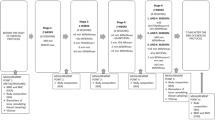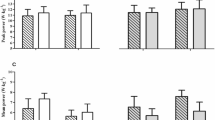Abstract
Weight-bearing exercise has been shown to maintain or increase bone mass in younger as well as older individuals but the mechanisms by which mechanical loading affects bone metabolism are not known in detail. Twelve postmenopausal women participated in a single bout of brisk walking (50% of VO2 max) for 90 minuttes. Calciotropic hormones and markers of type I collagen formation (PICP) and degradation (ICTP) were measured before the exercise, and 1, 24, and 72 hours following the exercise. Total body bone mineral content (BMC) and density (BMD) were measured by dual energy X-ray absorptiometry (DXA). Brisk walking did not induce any significant changes in the concentrations of ionized calcium, parathyroid hormone (PTH), calcitonin, or osteocalcin. A significant increase of PICP was noted 24 and 72 hours (P<0.01) after exertion and a significant decrease in the concentration of serum ICTP at 1 hour (P<0.05) was followed by an increase at 72 hours (P<0.001). There was no significant difference between the increases in the concentrations of PICP and ICTP at 72 hours. Strong inverse correlations between the basal levels of PTH and BMD (r=−0.78;P<0.01) as well as between osteocalcin and BMD (r=−0.83;P<0.01) were noticed. The changes in serum levels of bone collagen markers indicate an altered bone collagen turnover due to this moderate endurance exercise. The results also support the fact that serum levels of PTH as well as those of osteocalcin are associated with total body BMD in postmenopausal women.
Similar content being viewed by others
References
Snow-Harter C, Bouxsein M, Lewis BT, Carter DR, Markus R (1992) Effects of resistance and endurance exercise on bone mineral status of young women: a randomized exercise intervention trial. J Bone Miner Res 7:761–769
Suominen H (1993) Bone mineral density and long-term exercise. Sports Med 16:316–330
Gutin B, Kasper MJ (1992) Can vigorous exercise play a role in osteoporosis prevention? A review. Osteoporosis Int 2:55–69
Krölner B, Toft B, Töndevold E (1983) Physical exercise as prophylaxis against involutional vertebral bone loss: a controlled trial. Clin Sci 64:541–546
Revel M, Mayoux-Benhamou MA, Rabourdin JP, Bagheri JP, Roux C (1993) One-year psoas training can prevent lumbar bone loss in postmenopausal women: a randomized trial. Calcif Tissue Int 53:307–311
Woo S, Knei S, Amiel D (1981) The effect of prolonged physical training on the properties of long bone: a study of Wolff's law. J Bone Joint Surg 63A:780–787
Frost HM (1987) Bone “mass” and the “mechanostat”: a proposal. Anat Rec 219:1–9
Rubin C, Lanyon LJ (1984) Regulation of bone formation by applied dynamic load. J Bone Joint Surg 66A:397–402
Snow-Harter C, Marcus R (1989) Exercise add regulation of bone mass. Bone 6:45–48
Law MR, Wald NJ, Meade TW (1991) Strategies for prevention of osteoporosis and hip fracture. BMJ 303:453–459
Cummings SR, Nevitt MC, Browner WS, Stone K, Fox KM, Ensrud KE, Cauley J, Black D, Vogt TM (1995) Risk factors for hip fracture in white women. N Engl J Med 332:767–773
Tinetti ME, Baker DI, McAvay G, Claus EB, Garrett P, Gottschalk M, Koch ML, Trainor K, Horwitz RI (1994) A multifactorial intervention to reduce the risk of falling among elderly people living in the community. N Engl J Med 331: 821–827
Mellko J, Niemi S, Risteli L, Risteli J (1994) Radioimmunoassay of the carboxyterminal propeptide of human type I procollagen. Clin Chem 36:1328–1332
Risteli J, Melkko J, Niemi S, Risteli L (1991) Use of a marker of collagen formation in osteoporosis studies. Calcif Tissue Int (suppl) 49:S24-S25
Eriksen E, Charles P, Melsen F, Mosekilde L, Risteli L, Risteli J (1991) Serum markers of type I collagen formation and degradation in metabolic bone disease: correlation with bone histomorphometry. J Bone Miner Res 8:127–132
Trivedi P, Risteli J, Risteli L, Hindmarsh PC, Brook CGD, Mowat AP (1991) Serum concentrations of the Type I and III procollagen propeptides as biochemical markers of growth velocity in healthy infants and children and in children with growth disorders. Pediatr Res 30:276–280
Charles P, Mosekilde L, Risteli J, Risteli J, Eriksen EF (1994) Assessment of bone remodeling using biochemical indicators of type I collagen synthesis and degradation: relation to calcium kinetics. Bone Miner 24:81–94
Brahm H, Ljunggren Ö, Larsson K, Lindh E, Ljunghall S (1994) Effects of infusion of parathyroid hormone and primary hyperparathyroidism on formation and breakdown of type I collagen. Calcif Tissue Int 55:412–416
Kristoffersson A, Hultdin J, Holmlund I, Thorsen K, Lorentzon R (1995) Effects of short-term maximal work on plasma calcium, parathyroid hormone, osteocalcin and biochemical markers of collagen metabolism. Int J Sports Med 16:145–149
Fellman N (1992) Hormonal and plasma volume alterations following endurance exercise. A brief review. Sports Med 13:37–49
van Beaumont W (1972) Evaluation of hemoconcentration from hematocrit measurements. J Appl Physiol 32:712–713
Christiansen C (1993) Skeletal osteoporosis. J Bone Miner Res 8(suppl 2):S475–480
Avioli LV (1993) Hormonal alterations and osteoporotic syndromes. J Bone Miner Res 8(suppl 2):S511–514
Harms HM, Neubauer O, Kayser C, Wüstermann PR, Horn R, Brosa U, Schlinke E, Külpman W-R, von zur Mühlen A, Hesch R-D (1994) Pulse amplitude and frequency modulation of parathyroid hormone in early postmenopausal women before and on hormone replacement therapy. J Clin Endocrinol Metab 78:48–52
Boucher A, D'Amour P, Hamel L, Fugère P, Gascon-Barré M, Lepage R, Ste-Marie LG (1989) Estrogen replacement decreases the set point of parathyroid hormone stimulation by calcium in normal postmenopausal women. J Clin Endocrinol Metab 68:831–836
Ljunghall S, Joborn H, Roxin LE, Rastad J, Wide L, Åkerstrøm G (1986) Prolonged low-intensity exercise raises the serum parathyroid hormone levels. Clin Endocrinol 25:535–542
Salvesen H, Piehl-Aulin K, Ljunghall S (1994) Change in levels of the carboxyterminal propeptide of type I procollagen, the carboxyterminal cross-linked telopeptide of type I collagen and osteocalcin in response to exercise in well-trained men and women. Scand J Med Sci Sports 4:186–190
Virtanen P, Viitasalo JT, Vouri J, Väänänen K, Takala TES (1993) Effect of concentric exercise on serum muscle and collagen markers. J Appl Physiol 3:1272–1277
Nishiyama S, Tomoeda S, Ohta T, Higuchi A, Matsuda I (1988) Differences in basal and postexercise osteocalcin levels in athletic and nonathletic humans. Calcif Tissue Int 43:150–154
Author information
Authors and Affiliations
Rights and permissions
About this article
Cite this article
Thorsen, K., Kristoffersson, A. & Lorentzon, R. The effects of brisk walking on markers of bone and calcium metabolism in postmenopausal women. Calcif Tissue Int 58, 221–225 (1996). https://doi.org/10.1007/BF02508639
Received:
Accepted:
Issue Date:
DOI: https://doi.org/10.1007/BF02508639




